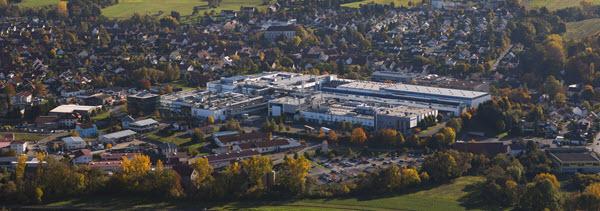Baxter Leads Hemodialysis Research Consortium for German Federal Ministry of Education and Research
Research aimed at improving health-related, quality-of-life outcomes for hemodialysis patients
Novel exploration of anticoagulant-free hemodialysis will investigate expanding function of dialysis membranes
World-class Baxter research and development team in Hechingen, Germany, to lead consortium

World-class Baxter research and development team in Hechingen, Germany, to lead consortium investigating anticoagulant-free hemodialysis.
DEERFIELD, Ill. -
Baxter International Inc. (NYSE:BAX), a global innovator in renal care, today announced receipt of a major research and development (R&D) grant from the German Federal Ministry of Education and Research (BMBF)’s “From Material to Innovation” program to lead a consortium investigating an anticoagulation-free hemodialysis (HD) option for end-stage renal disease (ESRD) patients. The grant provides €1.5 million in funding over three years to Baxter’s research team in Hechingen, Germany, and the consortium partners to find a solution that will improve health-related, quality-of-life outcomes for the millions of patients receiving HD therapy globally.
Anticoagulant use is a necessary component of HD that helps prevent blood clotting during therapy sessions, which are typically performed three days a week for an average of four hours per session. HD patients can experience short-term side effects from the anticoagulants, such as increased bleeding time at the end of a dialysis session.1 Some patients also experience long-term, cumulative effects of the drugs, such as increased risk of osteoporosis and endocrinology disorders that cause disruption to sodium and potassium levels, and a breakdown of essential proteins.2
The consortium is taking a novel approach to its research by analyzing modifications of dialysis membranes to minimize the interaction between blood and membrane surfaces — which is the main cause of blood clotting. The Baxter-led consortium brings together leading experts on polymer membrane science, active and interactive materials and functional nanostructured interfaces from the DWI Leibniz Institute for Interactive Materials Aachen and the Leibniz-Institute for Polymer Research Dresden, as well as innovative tools for the analysis of blood-material interactions from Hot Screen GmbH in Reutlingen.
“We are uniquely positioned to challenge standards and transform the quality of renal care treatment options through the work of our dedicated, world-class research and development teams,” said Sumant Ramachandra, M.D., Ph.D., senior vice president, chief science and technology officer, Baxter. “Our team in Hechingen is the global leader in membrane research and development, which is why we are confident our colleagues will lead this consortium in successfully exploring an anticoagulant-free dialysis option to improve patient outcomes globally.”
In 2012, Baxter received a grant from BMBF’s “BioMatVital: BioDisposabes” project to investigate a new generation of dialysis membranes to improve the treatment of chronic inflammation in ESRD patients. This research helped inform the company’s development of the Theranova dialyzer, which is a unique type of HD therapy that extends the range of molecules that can be filtered from the blood, resulting in a clearance profile that more closely mimics the natural kidney.3,4 HDx enabled by the Theranova dialyzer is available in Canada and select European, Latin American and Asian markets, and is currently an investigational device in the United States.
About Baxter
Every day, millions of patients and caregivers rely on Baxter’s leading portfolio of critical care, nutrition, renal, hospital and surgical products. For more than 85 years, we’ve been operating at the critical intersection where innovations that save and sustain lives meet the healthcare providers that make it happen. With products, technologies and therapies available in more than 100 countries, Baxter’s employees worldwide are now building upon the company’s rich heritage of medical breakthroughs to advance the next generation of transformative healthcare innovations. To learn more, visit www.baxter.com and follow us on Twitter, LinkedIn and Facebook.
Rx Only. For safe and proper use of the devices mentioned herein, refer to the Theranova Instructions for Use.
This release includes forward-looking statements concerning THERANOVA, including potential benefits associated with its use. The statements are based on assumptions about many important factors, including the following, which could cause actual results to differ materially from those in the forward-looking statements: satisfaction of regulatory and other requirements; actions of regulatory bodies and other governmental authorities; product quality, manufacturing or supply, or patient safety issues; changes in law and regulations; and other risks identified in Baxter's most recent filing on Form 10-K and other SEC filings, all of which are available on Baxter's website. Baxter does not undertake to update its forward-looking statements.
Baxter and Theranova are registered trademarks of Baxter International Inc.
[1] Bramham, K., et al. (2008). "Comparison of Tinzaparin™ and Unfractionated Heparin as Anticoagulation on Haemodialysis: Equal Safety, Efficacy and Economical Parity." Nephron Clinical Practice 110(2): c107-c113
[2] Shen, J. I. and W. C. Winkelmayer (2012). "Use and safety of unfractionated heparin for anticoagulation during maintenance hemodialysis." Am J Kidney Dis 60(3): 473-486
[3] Boschetti-de-Fierro A, et al. MCO membranes: Enhanced Selectivity in High-Flux Class. Scientific Reports (2015); 5: 18448.
[4] Kirsch AH, et al. Performance of hemodialysis with novel medium cut-off dialyzers. Nephrol Dial Transplant. 2017;32:165-172.